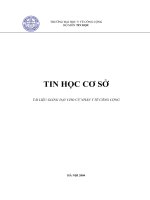Tin học cơ sở 3 pot
Bạn đang xem bản rút gọn của tài liệu. Xem và tải ngay bản đầy đủ của tài liệu tại đây (230.71 KB, 26 trang )
Tin h c c s 3ọ ơ ở
Structure
Outline
•
Structured Data types
•
Structures as function arguments
•
Self-referential types: linked list
Lê Nguyên Khôi 2
Structure
•
2
nd
aggregate data type: struct
•
Recall: aggregate meaning "grouping"
–
Recall array: collection of values of same type
–
Structure: collection of values of different types
•
Treated as a single item, like arrays
•
Major difference: Must first "define"
struct
–
Prior to declaring any variables
Lê Nguyên Khôi 3
Structure
•
Many structured collections of data are:
–
Heterogeneous (components are different types)
–
Fixed-size (well-defined set of components)
•
For example:
Student Record
Name Nguyen Van A
Student Id 1234567
Course INT1005
Date of Birth 01/01/1993
Gender Male
Lê Nguyên Khôi 4
Structured Data Types
•
A structure is a collection of
variables, perhaps of different
types, grouped together under a
single name.
•
Structures:
–
Help to organize complicated data into manageable
entities.
–
Expose the connection between data within an entity
–
Are defined using the struct keyword.
–
Sometimes referred as records.
Lê Nguyên Khôi 5
Structured Data Types
•
Define struct globally (typically)
•
No memory is allocated
–
Just a “placeholder” for what struct will “look like”
•
To define struct, we must give:
–
Name of struct
–
Name of each field
–
Type of each field (could be another
record/struct)
Lê Nguyên Khôi 6
Defining Struct
•
Defining a new data type using struct
struct date name of new "type"
{
int day; member names
int month;
int year;
}; “;” after “}”
struct date yesterday;
•
Once defined, this new data type could be
used as other data types:
–
Variable of this type could be assigned to another variable of the same
type
–
Variable of this type could be passed as a parameter to a function
Lê Nguyên Khôi 7
Declare Structure Variable
•
With structure type defined, now declare
variables of this new type:
struct date today;
–
Just like declaring simple types
–
Variable today now of type struct date
–
It contains "member values"
•
Each of the struct "parts"
Lê Nguyên Khôi 8
Accessing Structure Members
•
Dot Operator to access members
–
today.day
–
today.month
–
today.year
•
Called "member variables"
–
The "parts" of the structure variable
–
Different structs can have same name member
variables
•
No conflicts
Lê Nguyên Khôi 9
Defining New Type Struct
•
Could use typedef to define a new type
struct
typedef struct date Date;
•
And then we could use Date as other
basic type without the need of
including struct
Date today;
•
Compare to previous declaration of
yesterday
struct date yesterday;
Lê Nguyên Khôi 10
Structure Example
void printData(Date today)
{
printf("The day is: %i", today.day);
printf("The month is: %i", today.month);
printf("The year is: %i", today.year);
}
void getData(Date *today);
Lê Nguyên Khôi 11
Structure Initialization
•
Can initialize at declaration
–
Example:
struct date {
int day;
int month;
int year;
};
typedef struct date Date;
Date dueDate = {31, 12, 2013};
–
Declaration provides initial data to all three member
variables
Lê Nguyên Khôi 12
Structure Assignments
•
Given structure named Fruit
•
Declare two structure variables:
Fruit apples, oranges;
–
Both are variables of type "Fruit"
–
Simple assignments are legal:
apples = oranges;
•
Simply copies each member variable from apples
into member variables from oranges
Lê Nguyên Khôi 13
Structure Other Operations
•
Operations which are NOT defined for struct
type:
–
compare for equality/inequality
(i.e. apples == oranges is not a legal expression)
–
compare based on ordering (<, >, )
(i.e. apples < oranges is not a legal expression)
–
arithmetic operations
(i.e. apples + oranges is not a legal expression)
–
reading from or writing to text files
(i.e. no printf(apples) no scanf(&oranges))
•
If you need such operations, write your own
functions.
Lê Nguyên Khôi 14
Structure and Pointer
•
As for other types:
–
(struct x)* is a pointer to struct x
–
& gives the address of a structure
•
There are precedence problems because .
binds more tightly than *
•
If p is a pointer to a struct and a is a
field of the struct:
–
*p.a means *(p.a) which is ILLEGAL.
–
You must use (*p).a
–
For convenience , the operator -> combines indirection and
component selection.
–
p->a is equivalent to (*p).a
Lê Nguyên Khôi 15
Structure and Pointer
struct point {
int x, y;
};
struct point a;
struct point *ap;
ap = &a;
*ap.x = 0; /* wrong */
/* equivalent to *(ap.x) = 0;*/
(*ap).y = 0; /* right */
ap->x = 0; /* right */
Lê Nguyên Khôi 16
Structure and Pointer
void getData(Date *today)
{
printf("Enter day: ");
scanf("%i", &((*today).day));
printf("Enter month: ");
scanf("%i", &(today->month));
printf("Enter year: ");
scanf("%i", &today->year);
}
Lê Nguyên Khôi
Structure as Function Argument
•
Passed like any simple data type
–
Pass-by-value
–
Pass-by-reference
–
Or combination
•
Can also be returned by function
–
Return-type is structure type
–
Return statement in function definition
sends structure variable back to caller
Lê Nguyên Khôi 18
Other Type Definition
•
We can use the keyword typedef to
make our own definitions:
typedef float Floating;
•
This means variables can be declared
as Floating but they will actually be
of type float.
•
If we later decide we need more
precision, we can change to:
typedef double Floating;
without changing the codes.
Lê Nguyên Khôi 19
Combining struct and typedef
struct employee {
char name[30];
int id;
char position[20];
float salary;
};
typedef struct employee Employee;
Employee john;
•
Note: we use the convention that the name of the
defined type is the same as the struct modifier,
but with the first letter capitalized.
Lê Nguyên Khôi 20
Self-referential types
•
A very powerful programming technique
is to create struct with fields which
contain a reference to an object in
the same struct. For example:
struct list_node {
int data;
struct list_node *next;
};
•
This approach can be used to create
some very useful data structures.
Lê Nguyên Khôi 21
Linked Lists
•
Consider the following data
structure:
–
A list that grow over time
–
Items are added one by one
–
Each item is a number
•
It might grow like this:
Lê Nguyên Khôi 22
Linked Lists
•
How do you implement such a list in C++?
•
You can use an array but you must check the
array doesn't overflow and allocate memory
for a new larger array if the array fills.
•
Can be implemented using a self-referential
type.
•
Each element in the linked list need:
–
some information (the data)
–
a connection to the next item
•
The individual elements in data structures
like this are often called nodes.
Lê Nguyên Khôi 23
Linked Lists
•
A node could be represented by this
struct list_node {
int data;
struct list_node *next;
};
•
How can we represent the whole list?
•
We need a pointer to the first node:
struct list_node *list_start;
•
How can we represent the ``end of list''?
The next field of the struct will be NULL.
Lê Nguyên Khôi 24
Linked Lists
Lê Nguyên Khôi 25









